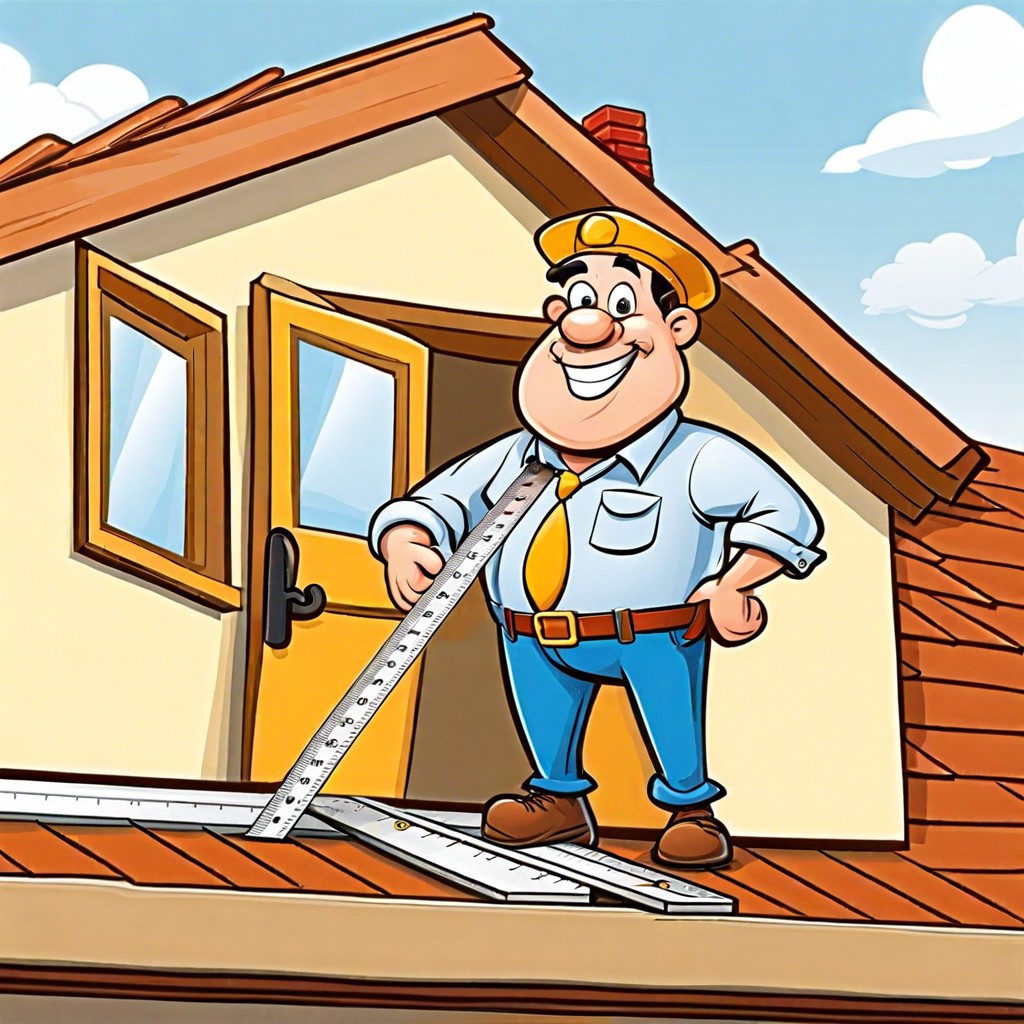Want to estimate the square footage of your roof accurately?
Got a roof to measure and feeling a bit overwhelmed? Don’t sweat it! Whether you’re prepping for a home improvement project or just curious about your roof’s size, this guide has got your back. We’ll walk you through every step, from gathering your gear to calculating those tricky slopes. Ready? Let’s dive into the world of roof measuring—math skills optional!
Key takeaways:
- Gather tools for accurate measurements.
- Measure roof length and width carefully.
- Calculate pitch to adjust for slope.
- Divide roof into manageable sections.
- Verify all measurements for accuracy.
Gather Necessary Tools

Don’t worry, we’re not going on a space mission here, just your roof. Arm yourself with the following essentials:
A sturdy ladder – we need to reach the top, right?
A measuring tape – nothing fancy, just something that won’t break halfway.
A notebook and pen – keep track of those measurements. Trust me, your memory isn’t as good as you think it is.
A calculator – unless you enjoy mental math marathons.
A level – because wonky measurements make no friends.
Last but not least, a buddy. Climbing on roofs alone is as smart as trying to tickle a bear. Safety first, folks!
Measure Roof’s Length and Width
Grab a sturdy ladder and a reliable measuring tape. Your best friend here is accuracy. Measure the length and width of your roof straight across, edge to edge. Stay safe, no rooftop gymnastics.
Got a rectangular roof? Great, simple measurements will do. But if your roof decides to be a bit fancy with shapes, take it section by section. Jot down those numbers, they’re your golden ticket.
By the way, trying to win an award for “Most Precise Roofer”? Measure both sides to double-check your work. Keeping it real, you’ll sleep better knowing your numbers are spot-on.
Calculate Pitch of the Roof
Now, let’s talk pitch. Imagine your roof is trying out for a singing competition, only its pitch determines its steepness. Most residential roofs fall into the “not too flat, not too steep” category, kind of like Goldilocks’ favorite porridge.
To find the pitch, measure the vertical rise over a 12-inch horizontal run. Think of it like a periscope rising from a submarine – up it goes, 12 inches out it extends. Simple right? With a tape measure and a level, you can conquer this.
Grab your level, place one end against the roof. Hold it so it’s level (bubble in the middle, folks). Measure vertically from the roof’s surface up to the bottom edge of your level. Voilà, that’s your rise.
Let’s say you get 6 inches for your rise. That means your roof’s pitch is 6:12. Easy peasy. If you got something else, just plug your numbers in the same way. Now you’re ready to move on, pitch-perfect!
Adjust for Roof Slope
To get a true sense of the roof’s square footage, you have to consider its slope. No, you can’t just eyeball it like judging a school play.
First, determine the pitch, which expresses the steepness as a ratio of the rise (vertical) over the run (horizontal). It’s not a math exam, just a little fraction action.
A steeper roof will naturally cover more surface area. Think of it like a pizza slice: a thicker crust means more tasty goodness.
Use your pitch ratio to find a correction factor. For example, a 6:12 pitch (6 inches of rise for every 12 inches of run) has a correction factor of about 1.12. It’s like upgrading your coffee from regular to grande; a bit more of everything.
Multiply your basic area measurement by this factor. Voilà! Now you’ve got the true area, with all those sneaky slopes accounted for. Just another reason geometry rules!
Divide Roof Into Measurable Sections
Imagine your roof is a jigsaw puzzle. Start by looking at it as a series of rectangles, triangles, and perhaps a stray trapezoid or two. This makes it easier to measure.
- For each segment:
- Visualize and sketch the roof, breaking it down to simpler shapes.
- Measure the dimensions of each of these shapes.
- Keep a note of which segment is which, so you don’t mix up your calculations later.
Trying to measure an entire roof in one go is like trying to eat a whole pizza in one bite. Not that I haven’t tried, but trust me, it’s easier to go slice by slice.
Add All Sections Together
Now that you’ve got all your measurements, it’s time to do some simple math. Think of it as putting together the pieces of a puzzle, but without the threat of finding out you’re missing an edge piece.
First, add up the square footage of each individual section. Got a calculator handy? Fantastic. If you’ve got a main section that’s 1,200 square feet and an adjoining section that’s 800 square feet, your total at this point is 2,000 square feet.
Next, if there are any tricky little dormers or oddly shaped areas, don’t forget to account for those. Even the smallest piece matters, kind of like the last cookie crumb on a plate—it still counts!
Finally, take a moment to double-check everything. Errors are sneaky devils. You don’t want to be haunted by a math mistake. Plus, nothing impresses the neighbors like being impeccably accurate about your roof’s square footage.
Verify Measurements and Calculations
Accuracy is everything. Double-check your work to avoid any roof-raising mistakes.
- Re-measure lengths and widths to ensure they match your initial numbers. Better safe than soaked, right?
- Cross-verify pitch calculations by measuring on both sides of the roof. Consistency is key – and it keeps your home snug.
- If you’ve divided the roof into sections, re-check each section’s measurements. Small errors here can lead to big misjudgments.
These steps will save you from budget-busting surprises and potential leaks. Trust me, your future dry self will thank you.